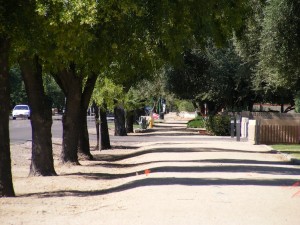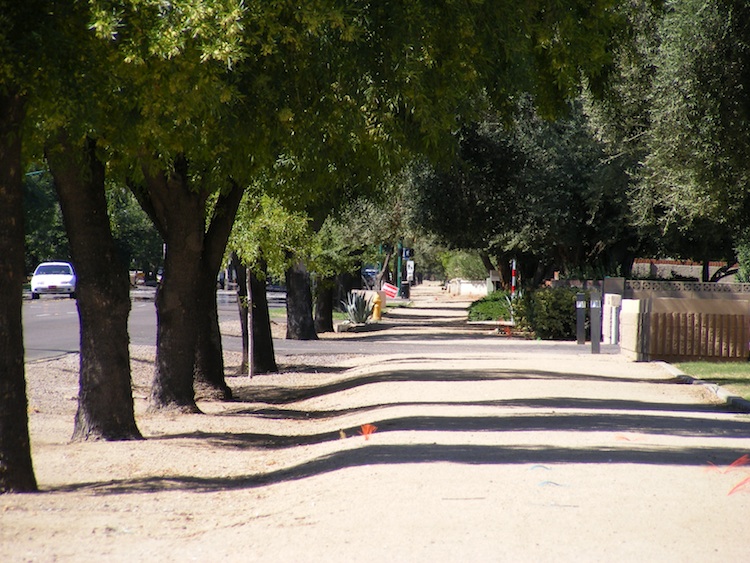 Yesterday, I posted this quote on the Blooming Rock Facebook Fan Page:
Yesterday, I posted this quote on the Blooming Rock Facebook Fan Page:
“One generation plants the trees; another gets the shade.” – Clarence Darrow
and I learned from Jo Marie McDonald, vice president of the Phoenix Community Alliance, that there is actually a Tree and Shade Master Plan in place for the City of Phoenix. The first step of this Master Plan is to raise awareness. To help with this, every Wednesday for the next month, I’ll be featuring parts of this document on the Blooming Rock blog. With the crippling budget cuts, the City is too understaffed and overstretched to push this plan right now. But can we get a little verve going for it with some grassroots community support? Can we, as a community, help implement this plan to restore our depleted urban forest in a sustainable way?
(Excerpts from the Tree and Shade Master Plan are shown in italics)
The Urban Forest:
The urban forest is a critical component of the living infrastructure. It benefits and attracts residents and tourists alike to live, work, shop and play in the city. Phoenix’s urban forest is a diverse ecosystem of soils, vegetation, trees, associated organisms, air, water, wildlife and people. The urban forest is found not only in parks, mountain preserves and native desert areas, but also in neighborhoods, commercial corridors, industrial parks and along streets. The urban forest is made up of a rich mosaic of private and public property that surrounds the city and provides many environmental, economic, and social benefits.
The urban forest is a keystone to creating a sustainable city because it solves many problems with one single solution. By investing in trees and the urban forest, the city can reduce its carbon footprint, decrease energy costs, reduce storm water runoff, increase biodiversity, address the urban heat island effect, clean the air, and increase property values. In addition, trees can help to create walkable streets and vibrant pedestrian places. More trees will not solve all the problems, but it is known that for every dollar invested in the urban forest results in an impressive return of $2.23 in benefits.
Phoenix, like many other cities, has deferred the care of the living infrastructure. Trees are being lost at a faster rate than they are being replaced, and the budget has not been able to support the City’s forestry efforts and urban forestry maintenance staff. For several decades the coordination, care and management of the forest has been under funded. This has created increased environmental, economic and social costs for the city and its residents.
As you can see, there is a certain urgency behind this plan. We can’t wait forever to start restoring our urban forest. The longer we wait, the harder it’ll be to correct our course. While we straighten out our economy and the City figures out its budget problems, our urban forest continues to be depleted. Can we as a community take charge of this and become stewards of existing trees and foster new ones?
What do you think? Leave me a comment.




















The concept of the urban forest is so important yet not talked about enough!! Well planted and maintained trees really change the ambience (and the temperature!) of a location. A good example, I think, of urban forestry is the shopping center at 16th st and Camelback. There is a nice spread of Palo verde trees to park and walk under and it gives this otherwise nondescript strip mall a certain character most of these places are sorely lacking. Thanks for this post!
Anais, I agree with you, this is such an important concept that rarely, if ever, gets any attention at all. I go to the shopping center on 16th and Camelback alot and it does seem that that area has a healthier urban forest than other places in town. I think trees can make the biggest difference in parking lots in a shopping center situation, not only making the experience better, but because it would mitigate some of the heat island effects of the parking lot itself.
Hi Taz, thanks for the information about the Phoenix Tree and Shade Master Plan. It was unfortunate but understandable to read that the budget cuts have hit that program hard. I posted an offshoot of your article over on my blog, featuring photos of some of the trees I see regularly along the Arizona Canal.
http://onespeedgo.blogspot.com/2010/08/still-standing-still-riding-trees-in.html
Thanks John…trees along the canals are the best, excellent shade for biking…
Urban forestry should be part of basic infrastructure here in Phoenix. Period.
Agreed Diane!
[…] series on The Phoenix Tree and Shade Master Plan. Last week I talked about the concept of the Urban Forest and why it’s important. Today I’m going to try to address this notion quoted in the […]
[…] the third installment of a month-long Wednesday series on The Phoenix Tree and Shade Master Plan. Part I was all about the definition of what an urban forest is and last Wednesday, I discussed the […]
[…] Phoenix Tree and Shade Masterplan series, the first step outlined in the Masterplan to restore our urban forest is Raising Awareness. The second is Preserve, Protect and Increase. Today I’ll be talking […]
Thanks for this look at Phoenix’s plan for the urban forest. The budget situation is upsetting for all concerned, but there is one hopeful note — trees are so beloved by their communities that there is real potential for a strong volunteer effort toward their care. Of course this won’t obviate the need for participation and some expense to the city, but if citizen foresters and community volunteers can take on much of the responsibility then promoting Phoenix’s urban forest economically becomes a real option.
Yes, I think we can definitely rally the community to take care of trees. I believe there is an emotional connection between people and trees and getting people to pitch in to help maintain them might be easier than we think.
I think that this is an example of how our older neighborhoods which possess larger lots with flood irrigation rights become more interesting and vital. Central Phoenix, West Mesa, and North Tempe all have neighborhoods of right-sized ranch homes, close to the Light Rail line, with the potential for shade density.
good point Daniel…densely shaded neighborhoods would not only be wonderful for the neighborhoods themselves but would provide benefits for the entire city as well
[…] other ways to insert the serene influence of nature into busy cities. One is the presence of the urban forest, which comprises mostly of the trees and other plants around the city, but is not limited to those […]
[…] Rock: Speaking about shade, there’s that Tree and Shade Masterplan that the City came up with. How important do you think it is to have a healthy urban forest to the […]
Yes that was right, that urban forest can attracts residents and tourists alike to live, work, shop and play in the city but the thing is that it’s hard to established urban forest and it takes a lot of guts and skills on how to make this happen. In our county, there are urban forest and it was so beautiful that lots of people would like to live in the area or work in the area.
[…] Despite these challenges, Phoenix used to be known as the City of Gardens because of its many shade trees. But over time and for many reasons, much of the tree canopy that existed in the city before World War II has since been destroyed leading to an unacceptable depletion of our urban forest. […]
Great topic! I was walking in downtown just today, mentally comparing the quality of two “urban forests”. The first: lush, verdant, refreshing and welcoming between St Mary’s Basilica and the Diocesan Center (between Van Buren and Monroe, 3rd and 5th St). Even in the heat of the day, people were lying on the grass, sitting on the benches, taking their lunch. The second at the nearby Herberger theater along 3rd St: dusty, sun baked and uninviting. The trees serve only to give some texture (perhaps a bit of carbon reduction), and to mitigate the otherwise bland wall facing 3rd. Apparently, the designers did not want people to actually use this space since they did not provide any benches, and the canopy of trees is too thin to break the summer sun.
Great Topic.By investing trees in the urban forest that would be the best thing that we can do. Trees can help us to solve some problems. I strongly agree to this line “By investing in trees and the urban forest, the city can reduce its carbon footprint, decrease energy costs, reduce storm water runoff, increase biodiversity, address the urban heat island effect, clean the air, and increase property values.”Let invest for us and to the future generation.
Awesome topic ever. Investing trees would be a great things to do not just for today’s generation but also to the future generation. Thanks for sharing this topic to us.
This article is fantastic. Doing something to restore urban forest. Nice one! Thanks for sharing!
Investing a trees is a good idea. It doesn’t cost you too much if you invest on it. And the good thing about this one is that trees can solve of the present problem that some of the cities encountered at present. Thanks for sharing.